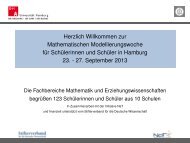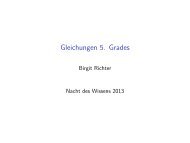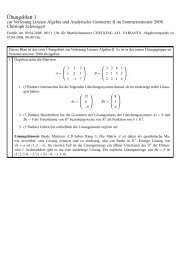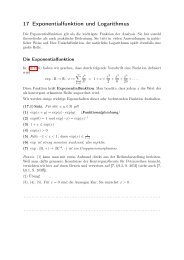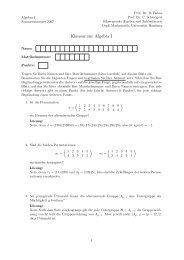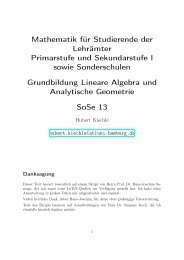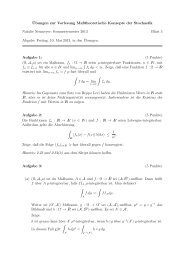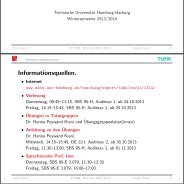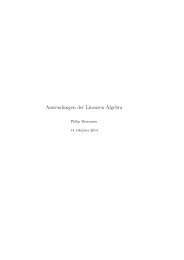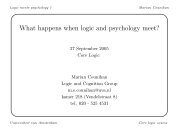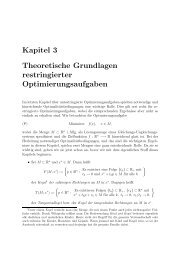pdf file
pdf file
pdf file
Create successful ePaper yourself
Turn your PDF publications into a flip-book with our unique Google optimized e-Paper software.
If the braided category is not strict, this amounts to a commuting diagram with 12 corners, a<br />
dodecagon. The reader should draw the graphical representation of this identity.<br />
In particular c V,V ∈ Aut (V ⊗V ) is a solution of the Yang-Baxter equation. Thus any object<br />
V of a braided tensor category provides a group homomorphism B n → Aut(V ⊗n ).<br />
Proof.<br />
The equality is a direct consequence of the hexagon axiom from definition 4.1.1 and the functoriality<br />
of the braiding:<br />
(c V,W ⊗ id U ) ◦ (id V ⊗ c U,W ) ◦ (c U,V ⊗ id W )<br />
= (c V,W ⊗ id U ) ◦ c U,V ⊗W [Hexagon axiom]<br />
= c U,W ⊗V ◦ (id U ⊗ c V,W ) [Functoriality, applied to c U,V ⊗W ]<br />
= (id W ⊗ c U,V ) ◦ (c U,W ⊗ id V ) ◦ (id U ⊗ c V,W ) [Hexagon axiom]<br />
It is an obvious question to ask what kind of structure on a Hopf algebra induces the<br />
structure of a braiding on its representation category.<br />
Definition 4.2.2<br />
1. Let H be a bialgebra. The structure of a quasi-cocommutative bialgebra is the choice of<br />
an invertible element R in the algebra H ⊗ H such that for all x ∈ H<br />
Δ opp (x)R = RΔ(x) . (9)<br />
R is called a universal R-matrix. A quasi-triangular Hopf algebra is a Hopf algebra together<br />
with the choice of a universal R-matrix.<br />
2. A quasi-cocommutative bialgebra H is called quasi-triangular, if its universal R-matrix<br />
obeys the relations in H ⊗3 (Δ ⊗ id H )(R) = R 13 ∙ R 23 (10)<br />
✷<br />
(id H ⊗ Δ)(R) = R 13 ∙ R 12 (11)<br />
with<br />
R 12 := R ⊗ 1, R 23 := 1 ⊗ R and R 13 := (τ H,H ⊗ id H )(1 ⊗ R) .<br />
3. A morphism f : (H, R) → (H ′ , R ′ ) of quasi-triangular Hopf algebras is a morphism<br />
f : H → H ′ of Hopf algebras such that R ′ = (f ⊗ f)(R).<br />
Remarks 4.2.3.<br />
1. In Sweedler notation R = R (1) ⊗ R (2) , the relations read<br />
x (2) R (1) ⊗ x (1) R (2) = R (1) x (1) ⊗ R (2) x (2)<br />
(R (1) ) (1) ⊗ (R (1) ) (2) ⊗ R (2) = R (1) ⊗ R ′ (1) ⊗ R (2)R ′ (2)<br />
R (1) ⊗ (R (2) ) (1) ⊗ (R (2) ) (2) = R (1) R ′ (1) ⊗ R′ (2) ⊗ R (2)<br />
93




